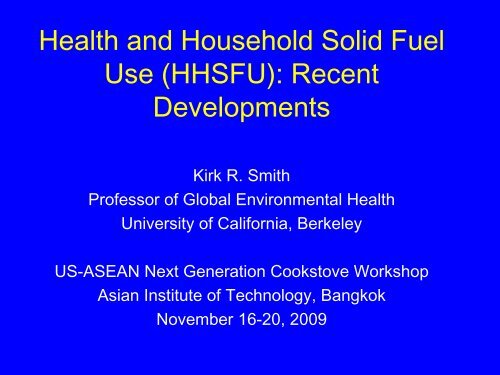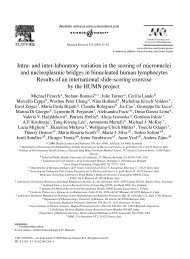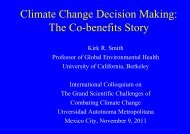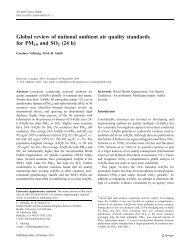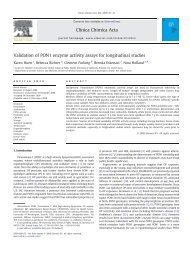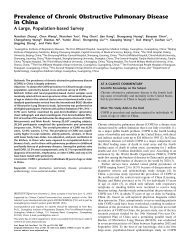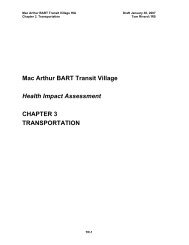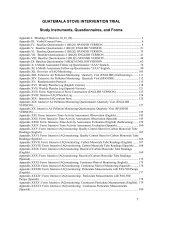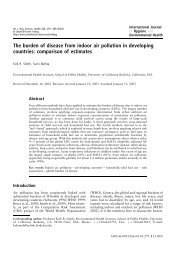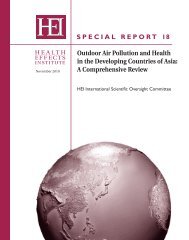Health and Household Solid Fuel Use (HHSFU) - Environmental ...
Health and Household Solid Fuel Use (HHSFU) - Environmental ...
Health and Household Solid Fuel Use (HHSFU) - Environmental ...
- No tags were found...
You also want an ePaper? Increase the reach of your titles
YUMPU automatically turns print PDFs into web optimized ePapers that Google loves.
Study design N* OR 95% CIIntervention 2 1.28 1.06, 1.54Cohort 7 2.12 1.06, 4.25Case-control 15 1.97 1.47, 2.64Cross-sectional 3 1.49 1.21, 1.85All 26 1.78 1.45, 2.18Dherani et al., 2008Bull WHO
There is growing evidence forinclusion of additional diseases• Adverse pregnancy outcomes – low birthweight <strong>and</strong>/or prematurity (APO leads to arange of childhood <strong>and</strong> adult diseases <strong>and</strong>increased mortality)• Lung <strong>and</strong> perhaps other cancers• ALRI in adults• Heart disease – here, however, evidenceis indirect, i.e., based on studies of othercombustion smoke mixtures.
Still insufficient <strong>and</strong>/or inconsistentevidence• Tuberculosis• Asthma
Evidence from Animal Studies –CO effects• Birth defects – cleft palette (lip)• Cognitive impacts – lower learning ability(IQ) in animals exposed through theirmothers during pregnancy• Can also expect effects on IQ if exposureoccurs during brain development, i.e. inearly childhood
Exposure Lessons, based on good data, butto date limited in geography• Even well-operating chimney stoves withoutsignificant changes in combustion efficiencyseem not to reduce average exposures by morethan a factor of 2-3.• Even if kitchen levels go down by a factor of 10.• Pollution is just moved, not eliminated• Most chimneys in the field do not operate atoptimal levels – thus real reductions over timeare less
Exposure, cont.• Field conditions, particularly the significantnatural variations in operator behavior <strong>and</strong>fuel used (type/size/moisture) lead tosubstantially lower performance thanmight be predicted from lab tests evenwhen the stove is used.• Also, some aspects of normal usage aredifficult to mimic in the lab, for examplelong-term smoldering between regularmeals
Adoption is important• We define adoption as the total meals for which thestove is used divided by the total meals actually cooked<strong>and</strong> thus it includes full, partial, <strong>and</strong> no use by differenthouseholds over time.• Adoption rates are not ever 100% even when stoves arebought.• There is growing recognition that even 70% over a longperiod may be pretty good• From a policy st<strong>and</strong>point, this kind of “intention to treat”approach makes most sense for planning. It is termed“effectiveness” in the health field• For promotion, of course, one would probably emphasizethe impact of full use as intended, which is called“efficacy” in the health field.
Lab performance of current generation ofadvanced combustion stoves• Substantial reduction of particles, volatileorganics, <strong>and</strong> other non-CO componentsof incomplete combustion – factors of 20-30 in some studies depending on themetric used.• Not such good reductions in CO, however,perhaps factors less than 5.• Still few field measurements
Problems of differential reduction ofCO <strong>and</strong> non-CO PICS• CO becomes the important limit to health acceptability ifno venting• Lower non-CO/CO ratio also means that even lower COemissions become more dangerous for short-term acutepoisoning risk – the ‘natural’ warning is stripped out.• Proposed new WHO Air Quality Guidelines for CO(approved by expert committee this month, but not yetofficial) will retain previous short-term limits (e.g., 100mg/m3 -86 PPM- for 15 minutes), but add a 24-h limit of7 mg/m3 ~6 PPM.• This is because of growing evidence of long-term chronichealth effects of CO that do not operate through changesin blood hemoglobin, e.g., on immune system• Expect, however, that the short-term rather than 24-hlimits will be the most important constraints on stoves inmost settings.
Other current issues• Black carbon particles, which are powerful globalwarming pollutants, seem as toxic as the other particlesin biomass smoke, but the first study of long-term healtheffects of BC being published next week does notprovide convincing evidence that they are more so.• This recent evidence, however, does strongly supportthat ozone <strong>and</strong> sulfates, which are produced downwindfrom precursors emitted by households <strong>and</strong> othersources, are major independent risks for health.• About one-sixth of human-generated ozone precursorsin the world come from household combustion• Thus, outdoor air pollution health effects from householdcombustion are now understood to be significant,particularly in large river basins with dense ruralpopulations, such as the Yangtze <strong>and</strong> Ganges.
20-month averageground-level PM2.5from satellite data
Although we have focused on finePM mass, remember• PM should be considered mainly as an indicatorof the non-CO PIC mixture, something wellestablished in other settings – outdoors,occupational, tobacco smoke, etc. Pure inertPM has much lower impacts – it is the stuff it ismixed with as much as the PM itself.• In the case of simple stoves, the PIC mixturecontains a wide range of other Non-PM noxiousmaterials – indeed in mass nearly 20 timesgreater than the PM (5-10 times more notincluding CO)
Toxic Pollutants in Biomass <strong>Fuel</strong> Smokefrom Simple (poor) Combustion• Small particles, CO, NO 2• Hydrocarbons– 25+ saturated hydrocarbons such as n-hexane– 40+ unsaturated hydrocarbons such as 1,3 butadiene– 28+ mono-aromatics such as benzene & styrene– 20+ polycyclic aromatics such as benzo()pyrene• Oxygenated organics– 20+ aldehydes including formaldehyde & acrolein– 25+ alcohols <strong>and</strong> acids such as methanolKnown toxins orcarcinogen in italics– 33+ phenols such as catechol & cresol– Many quinones such as hydroquinone Source: Naeher et al,J Inhal Tox, 2007– Semi-quinone-type <strong>and</strong> other radicals• Chlorinated organics such as methylene chloride <strong>and</strong> dioxin
Thus, it is probably true to say that• Not only is the highest total public PM exposurein world found in village households, but alsothose for• Formaldehyde• Benzene• PAH (both particulate <strong>and</strong> vapor)• Ultrafine particles• Dioxin• And many others• Probably not for CO, however, because in spiteof high peaks, mean levels are not highcompared to other public settings.
First R<strong>and</strong>omized TrialIn Air Pollution History*After a worldwide search, chose a site inin the Guatemalan Highl<strong>and</strong>s~3000 meters* In normal populationsCombustion pollutants with a normal population
RESPIRE: (R<strong>and</strong>omized Exposure Study of Pollution Indoors<strong>and</strong> Respiratory Effects)Highl<strong>and</strong>GuatemalaTraditional 3-stone 3open firePlancha chimney wood stove
Overview of RESPIRE study design• 530 eligible households: open fire, womanpregnant or or child less than 4 months• Baseline survey <strong>and</strong> exposure assessmentR<strong>and</strong>omizeYear 15500<strong>Household</strong>stotal totalKeep open fire firePlanchaFollow up up till till aged 18 18 months• Surveillance for for ALRI, diarrhoea, &c &c• Detailed exposure monitoringYears1-3 1-3Compare incidence <strong>and</strong> exposure in in 2 groupsPlancha offered to to ‘controls’Years3-4 3-4
TubitoTubito
Effect of the Chimney Stove on Infant Exposures in RESPIREChild CO exposure (ppm)0.5 1 2 3 4(a)ControlIntervention1888 48-hmeasurementsAbout 50%less exposureover the entireperiodSmith, et al,20090 5 10 15 20Time relative to intervention (months)
Unpublished results fromRESPIREhave been removedWatch the website below where they will beposted as soon as they are published.http://ehs.sph.berkeley.edu/krsmith
Adjusted Relative Risk2.52.01.5Exposure fromSecond h<strong>and</strong> cigarette smoke:Stars, from 2006 Surgeon General Report<strong>and</strong> INTERHEART study (Teo et al. 2006)And air pollution:Hex, from Womens <strong>Health</strong> Initiative cohort,includes all first cardiovascular events,(Miller et al. 2007);Diamonds, from ACS cohort(Pope et al. 1995, 2002, 2004);Triangles, Harvard Six Cities cohort(Dockery et al. 1993; Laden et al. 2006)WHO AQGHeart Disease RiskPope et al, 2009WHO IT-1<strong>Solid</strong> <strong>Fuel</strong>ZoneExposure from smoking
<strong>Health</strong> effects of Traditional <strong>Household</strong> <strong>Fuel</strong> <strong>Use</strong>This figure illustrates the wider effects oftraditional household biomass fuel use. Here,however, we only quantify the direct effects onhealth <strong>and</strong> global climate
ALRI < 5 years
Chronic Obstructive Pulmonary Disease
Ischaemic Heart Disease
Summary of Disease Burden Avoided
What’s coming• If the RESPIRE results are accepted forpublication in near their submitted form, HH SFUwill be on the international health map muchmore than ever before.• RESPIRE shows a potential benefit for the mostimportant cause of child mortality in the worldequal to or greater than vaccines or nutritionprograms – the other two major types ofintervention available.• Even so, it will be up to us to show that majorreductions in exposure can be reliably achievedat large scale as there is much cynicism on thispoint.
Bottom Line for Stoves• The biggest single question still remains• “Is it possible to promote a stove without achimney for health?”• Not only a question of lab <strong>and</strong> field performanceof the advanced combustion devices, but also• Can CO emissions be brought under WHOshort-term AQGs in a reliable manner
Best is both• Low emissions <strong>and</strong> high tolerance for fuel <strong>and</strong>operator variability• And a chimney• This is the approach taken in China• Remember, lower emissions means that thechimney as well as the people <strong>and</strong> the outsideenvironment is protected• Thus greatly reducing at least one problem withchimneys – poor lifetime <strong>and</strong> need for cleaning
Thank youPapers being published next week in the Lancet series on <strong>Health</strong>Benefits of Strategies to Reduce Greenhouse Gases will beavailable on my website shortly after. These include the new dataon black carbon health effects <strong>and</strong> the health benefits of the 150-million stove program in India;http://ehs.sph.berkeley.edu/krsmith/Watch the website also for the Guatemala pnemonia studies <strong>and</strong> thenew WHO Air Quality Guidelines, which both should be ready in thefirst few months of 2010.The new Comparative Risk Assessment should be out in mid-2010 <strong>and</strong>will also be found on the website when ready.


